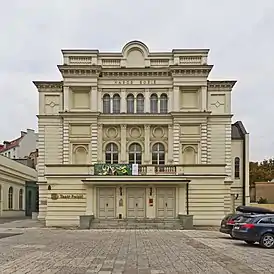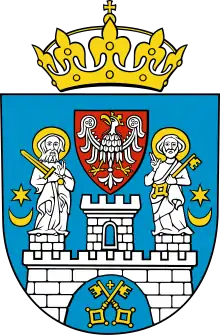Timeline of Poznań
Prior to 19th century
| History of Poland |
|---|
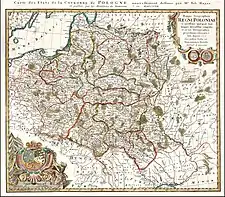 |
|
|
- 968 – Roman Catholic Diocese of Poznań established.
- 10th century – Poznań Cathedral built.
- 1038
- City taken by forces of Bretislaus I, Duke of Bohemia.
- Capital of Poland moved from Poznań to Kraków.
- 11th C. – St. Michael church built.
- 1249 – Castle construction begins (approximate date).
- 1253
- Town gains Magdeburg rights.
- Town Hall built.[1]
- 1290 - Capital of Poland moved from Kraków back to Poznań.
- 1296
- Wielkopolska Chronicle written.[2]
- Capital of Poland moved from Poznań back to Kraków.
- 1320 – Town becomes capital of the Poznań Voivodeship.
- 1341 – 29 September: Coronation of Adelaide of Hesse in Poznań Cathedral.
- 1518 – Lubrański Academy established.
- 1534 – Waga Miejska (weighing house) built.
- 1536 – Fire.[2]
- 1551 – Flood.[2]
- 1560 – Town Hall rebuilt on Market Square.
- 1563 – Cloth Hall rebuilt.
- 1573 – Jesuit College established.[2]
- 1611 - Origins of University in Poznań
- 1655 – Town taken by Swedish forces.
- 1677 – Jesuit printing press in operation.[3]
- 1704 – 9 August: Battle of Poznań.
- 1710 – Plague.[2]
- 1736 – Flood.[2]
- 1787 – Odwach (guardhouse) on Market Square rebuilt.
- 1793
- City annexed by Prussia in the Second Partition of Poland and included within the newly formed province of South Prussia[4]
- City renamed "Posen."
- 1796 – Population: 16,124.
19th century
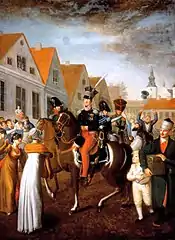
Entrence of Jan Henryk Dąbrowski to Poznań, painting of Jan Gładysz from 1809
- 1803 – Fire.[5]
- 1806 – Napoleon temporarily headquartered in city.[2]
- 1807 – Town becomes part of the Duchy of Warsaw.[4]
- 1815 – Town becomes part of Prussia again.[4]
- 1828 – Poznań Fortress construction begins.
- 1829 – Raczyński Library founded.[2][1]
- 1839 – Fort Winiary built.
- 1841 – Scientific Help Society for the Youth of the Grand Duchy of Poznań established.
- 1842 – Bazar Hotel founded.[2]
- 1846
- 1848 – Szczecin–Poznań railway begins operating.[2]
- 1857
- Society of Friends of Learning established.[2]
- Museum of Polish and Slavic Antiquities (present-day National Museum) founded.
- Israelitische Brüdergemeinde synagogue built.[6]
- 1871 – Grand Duchy of Poznań abolished.[2]
- 1872 – Kurjer Poznański newspaper begins publication.
- 1875 – Polish Theatre[7] and Stare Zoo established.
- 1879 – Poznań Central Station opens.[2]
- 1885
- 1891 – Richard Witting becomes mayor.
- 1895
- 1896 – Piotrowo and Berdychowo become part of city.[10]
- 1898 – Electric tramway begins operating.[2]
- 1900 – Górczyn, Jeżyce, Łazarz, and Wilda become part of city.[11]
20th century
1900–1939
- 1902 – Kaiser Wilhelm Library and Kaiser Friedrich Museum open.[8]
- 1903 – Royal Academy opens.[8]
- 1905 – Population: 136,808.[1]
- 1907 – Sołacz becomes part of city.[12]
- 1910
- Grand Theatre opens.
- Imperial Castle built.[1]
- Higher State School of Machinery founded.
- 1912 – Warta Poznań football club formed.
.jpg.webp)
First session of the Polish Provincial Sejm in Poznań (1918)
- 1918
- 3 December: The first session of the Polish Provincial Sejm (parliament) of the former Prussian Partition of Poland in Poznań.
- 27 December: Greater Poland Uprising (1918–19) against German rule begins.
- 1919 – Poznań University and Wielkopolskie Muzeum Wojska (military museum) founded.
- 1921 – Poznań Fair begins.[2]
- 1922 – Lutnia Dębiec football club formed.
- 1923 – Kronika Miasta Poznania (journal of city history) begins publication.
- 1925 – Dębiec, Główna, Komandoria, Rataje, Starołęka, Szeląg, and Winogrady become part of city.[13]
- 1927
- Poznań Radio Station established.[2]
- Ilustracja Poznańska begins publication.
- 1928 – Czarna Trzynastka Poznań wins its first and only Polish men's basketball championship.
- 1929 – Warta Poznań wins its first Polish football championship.
- 1930
- Population: 266,742.
- AZS Poznań wins its first Polish men's basketball championship.
- 1933 – Golęcin and Podolany become part of city.[14]
- 1935 – Lech Poznań wins its first Polish men's basketball championship.
World War II (1939–1945)
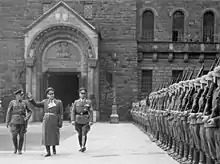
- 1939
- September: During the invasion of Poland at the beginning of World War II, near Słupca, the Germans bombed a train with Polish civilians fleeing the Wehrmacht from Poznań.[15]
- Poznań Nightingales (choir) secretly founded.
- 10 September: German troops invade Poznań, beginning of German occupation.[2]
- 10 September: Inhabitants of Poznań were among the victims of a massacre of Poles committed by German troops in Zdziechowa.[16]
- 12 September: The Einsatzkommando 1 and Einsatzgruppe VI paramilitary death squads entered the city to commit various crimes against the population.[17]
- September: Mass arrests of Poles by the occupying forces.[18]
- September: City made the headquarters of the central district of the Selbstschutz, which task was to commit atrocities against Poles during the German invasion of Poland.[19]
- October: Infamous Fort VII concentration camp established by the Germans for imprisonment of Poles arrested in the city and region during the Intelligenzaktion.[20]
- 16, 18, 20, 26, 28 October: Mass executions of 71 Polish prisoners in Fort VII. Among the victims were teachers, merchants, farmers, craftsmen, workers, doctors, lawyers, editors of Polish newspapers.[20]
- 8, 18, 29 November: Further executions of over 30 Polish prisoners in Fort VII. Among the victims were merchants, craftsmen, editors of Polish newspapers.[21]
- 12–16 November: German police and SS massacred 60 Polish prisoners of the Fort VII concentration camp in the forest of Dębienko near Poznań.[22]
- December: Further executions of 14 Polish craftsmen in Fort VII.[21]
- The Germans massacred over 630 Polish prisoners of the Fort VII concentration camp, incl. 70 students of Poznań universities and colleges and 70 nuns, in the forest of Dopiewiec near Poznań.[21]
- Ernst Damzog, former commander of the Einsatzgruppe V, was appointed the police inspector for both Sicherheitspolizei and Sicherheitsdienst in German-occupied Poznań.[23]
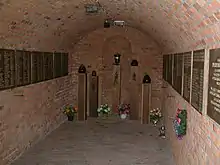
Bunker no. 16 in Fort VII, used by the German occupiers as an improvised gas chamber
- 1940
- January: Further executions of 67 Poles in Fort VII. Among the victims were teachers, local officials, engineers, artists, priests, professors and merchants.[21]
- 27 January, 20 February, 5 March, 25 April: The Germans massacred over 700 Polish prisoners of the Fort VII concentration camp, incl. 120 women, in the forest of Dębienko.[22]
- February, April and May: Further executions of 21 Poles in Fort VII.[21]
- Early 1940: The Germans massacred over 2,000 Polish prisoners of the Fort VII concentration camp in the forest of Dopiewiec.[21]
- 20 April: Over 100 Poles were arrested by the Germans in the city in just one day.[24]
- 1 August: Stalag XXI-D prisoner-of-war camp for Allied POWs established by the occupiers.
- 1941 – The German labor office in Poznań demanded that children as young as 12 register for work, but it is known that even ten-year-old children were forced to work.[25]
- 1943
- 14 September: Kidnapped Polish children from Poznań were deported to a camp for Polish children in Łódź, which was nicknamed "little Auschwitz" due to its conditions.[26]
- October: Reichsführer-SS Heinrich Himmler delivers Posen speeches.
- Lake Rusałka created.
- 1944
- April: Fort VII concentration camp dissolved.
- Aerial bombing by U.S. forces.[2]
- 1945
- January: Stalag XXI-D POW camp dissolved.
- January–February: Battle of Poznań.
- End of German occupation.
1945–1990s
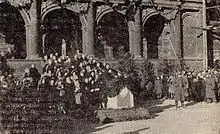
Burial of Polish composer Feliks Nowowiejski in 1946
- 1945 – Głos Wielkopolski newspaper begins publication.[9]
- 1947 – Poznań Philharmonic founded.
- 1950 – Population: 320,700.
- 1952 – Lake Malta created.
- 1954 – City administration divided into five dzielnicas: Stare Miasto, Nowe Miasto, Jeżyce, Grunwald, and Wilda.
- 1956
- Poznań 1956 protests.[27][28]
- Poznań Cathedral rebuilt.
- 1963
- Piątkowo transmitter erected.
- Wielkopolskie Muzeum Wojskowe (military museum) opens.
- 1964 – Teatr Osmego Dnia (theatre group) founded.[7]
- 1970 – Park Cytadela established.

Saint John's Fair in 1978
- 1971
- Grunwald Poznań wins its first Polish handball championship.
- Polonia Poznań wins its first Polish rugby championship.
- 1973 – Polish Dance Theatre founded.[7]
- 1974
- Hala Arena opens.
- Zoo established.
- Population: 502,800.[29]
- 1980 – Municipal Stadium opens.
- 1983 – Lech Poznań wins its first Polish football championship.
- 1987 – Kiekrz, Morasko, and Radojewo become part of city.
- 1989 – Lech Poznań wins its tenth Polish men's basketball championship.
- 1990
- Wojciech Szczęsny Kaczmarek becomes mayor.[30]
- Population: 590,049.
- 1991 – Gazeta Poznanska newspaper begins publication.[9]
- 1997
- Sekcja Rowerzystów Miejskich (bicycle advocacy group) active.
- Poznański Szybki Tramwaj (tramway) opens.
- 1998 – Ryszard Grobelny becomes mayor.[30]
- 1999 – City becomes capital of Greater Poland Voivodeship.
- 2000 – Polish 31st Air Base established near city.
21st century
- 2007 – Bishop Jordan Bridge opens to Ostrów Tumski.
- 2008
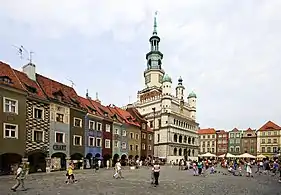
Poznań Old Town in 2012
- 2009 – Poznań co-hosts the EuroBasket 2009.
- 2010 – Population: 551,627.
- 2011
- City administration divided into 42 osiedles (neighbourhoods).
- Transatlantyk – Poznań International Film and Music Festival begins.
- 2012 – Poznań co-hosts the UEFA Euro 2012.
- 2013 - Homeless World Cup football contest held.[31]
- 2021
- 14 July: Honorary Consulate of Estonia opened.[32]
- 25 September: Enigma Cipher Centre established.
See also
References
- Britannica 1910.
- Łęcki 1997.
- "Drukarnia Kolegium Towarzystwa Jezusowego w Poznaniu 1677-1773". Wielkopolska Biblioteka Cyfrowa. April 1997. Retrieved 10 April 2019.
- Haydn 1910.
- Townsend 1867.
- "Poznań". Encyclopedia of Jews in Eastern Europe. Yivo Institute for Jewish Research. Archived from the original on October 2014.
- Don Rubin, ed. (2001). "Poland". World Encyclopedia of Contemporary Theatre. Vol. 1: Europe. Routledge. p. 634+. ISBN 9780415251570.
- Königliche Museen zu Berlin (1904). Kunsthandbuch für Deutschland (in German) (6th ed.). Georg Reimer.
- Europa World Year Book 2004. Taylor & Francis. ISBN 1857432533.
- "Statystyczna Karta Historii Poznania" (PDF). Główny Urząd Statystyczny. June 2008. Retrieved 10 April 2019.
- "Statystyczna Karta Historii Poznania" (PDF). Główny Urząd Statystyczny. June 2008. Retrieved 10 April 2019.
- "Statystyczna Karta Historii Poznania" (PDF). Główny Urząd Statystyczny. June 2008. Retrieved 10 April 2019.
- "Statystyczna Karta Historii Poznania" (PDF). Główny Urząd Statystyczny. June 2008. Retrieved 10 April 2019.
- "Statystyczna Karta Historii Poznania" (PDF). Główny Urząd Statystyczny. June 2008. Retrieved 10 April 2019.
- Wardzyńska, Maria (2009). Był rok 1939. Operacja niemieckiej policji bezpieczeństwa w Polsce. Intelligenzaktion (in Polish). Warszawa: IPN. p. 89.
- Wardzyńska (2009), p. 91
- Wardzyńska (2009), p. 113
- Wardzyńska (2009), p. 116
- Wardzyńska (2009), p. 63
- Wardzyńska (2009), p. 190
- Wardzyńska (2009), p. 191
- Wardzyńska (2009), p. 192
- Wardzyńska (2009), p. 54
- Wardzyńska (2009), p. 213
- Kołakowski, Andrzej (2020). "Zbrodnia bez kary: eksterminacja dzieci polskich w okresie okupacji niemieckiej w latach 1939-1945". In Kostkiewicz, Janina (ed.). Zbrodnia bez kary... Eksterminacja i cierpienie polskich dzieci pod okupacją niemiecką (1939–1945) (in Polish). Kraków: Uniwersytet Jagielloński, Biblioteka Jagiellońska. p. 74.
- Ledniowski, Krzysztof; Gola, Beata (2020). "Niemiecki obóz dla małoletnich Polaków w Łodzi przy ul. Przemysłowej". In Kostkiewicz, Janina (ed.). Zbrodnia bez kary... Eksterminacja i cierpienie polskich dzieci pod okupacją niemiecką (1939–1945) (in Polish). Kraków: Uniwersytet Jagielloński, Biblioteka Jagiellońska. pp. 147, 158.
- "Poland Profile: Timeline". BBC News. Retrieved 30 November 2013.
- Bernard A. Cook, ed. (2013). "Chronology of Major Political Events". Europe Since 1945: An Encyclopedia. Routledge. ISBN 978-1-135-17939-7.
- United Nations Department of Economic and Social Affairs, Statistical Office (1976). "Population of capital city and cities of 100,000 and more inhabitants". Demographic Yearbook 1975. New York. pp. 253–279.
- "Mayors of the City of Poznań". Poznań City Hall. Retrieved 28 November 2013.
- Tina Rosenberg (October 9, 2014), "In This World Cup, the Goal is a Better Life", New York Times
- "Otwarcie Konsulatu Honorowego Estonii w Poznaniu". warsaw.mfa.ee (in Polish). Retrieved 2 April 2022.
This article incorporates information from the Polish Wikipedia.
Bibliography
in English
- Published in 18th–19th centuries
- Richard Brookes (1786), "Posnania", The General Gazetteer (6th ed.), London: J.F.C. Rivington
- David Brewster, ed. (1830). "Posen". Edinburgh Encyclopædia. Edinburgh: William Blackwood.
- "Posen", Leigh's New Descriptive Road Book of Germany, London: Leigh and Son, 1837
- George Henry Townsend (1867), "Posen (Prussia)", Manual of Dates (2nd ed.), London: Frederick Warne & Co.
- "Posen". Handbook for North Germany. London: J. Murray. 1877.
- "Posen", Bradshaw's Illustrated Hand-book to Germany and Austria, London: W.J. Adams & Sons, 1898
- Published in 20th century
- "City of Posen", Jewish Encyclopedia, vol. 10, New York, 1907, hdl:2027/osu.32435029752854
- "Posen", Northern Germany (15th ed.), Leipzig: Karl Baedeker, 1910, OCLC 78390379
- . Encyclopædia Britannica. Vol. 22 (11th ed.). 1910.
- Benjamin Vincent (1910), "Posen", Haydn's Dictionary of Dates (25th ed.), London: Ward, Lock & Co.
- George Lerski (1996). "Poznan". Historical Dictionary of Poland, 966-1945. Greenwood. p. 472. ISBN 978-0-313-03456-5.
- Włodzimierz Łęcki (1997), Poznan: a City of History and Fairs, Poznan: GeoCenter Warszawa, ISBN 9788371502835
- Piotr Wróbel (1998). "Poznan". Historical Dictionary of Poland 1945-1996. Fitzroy Dearborn. p. 244. ISBN 978-1-135-92694-6.
in other languages
- Stadtbuch von Posen (in German), Posen: Eigenthum der Gesellschaft, 1892
- P. Krauss und E. Uetrecht, ed. (1913). "Posen". Meyers Deutscher Städteatlas [Meyer's Atlas of German Cities] (in German). Leipzig: Bibliographisches Institut.
External links
| Wikimedia Commons has media related to Poznań. |
- Links to fulltext city directories for Poznan via Wikisource
- Europeana. Items related to Poznań, various dates.
This article is issued from Wikipedia. The text is licensed under Creative Commons - Attribution - Sharealike. Additional terms may apply for the media files.
